Building of the Craft Association in Belgrade
| Building of the Craft Association in Belgrade | |
|---|---|
 Building of the Craft Association in Belgrade |
|
| Data | |
| place | Hilandarska Street 2, Belgrade |
| architect | Danilo Vladisavljević , Bogdan Nestorović |
| Construction year | 1933 |
| particularities | |
| Cultural monument | |
The building of the handicraft association is located in Belgrade at 2 Hilandarska Street . It was built for the needs of the handicraft association and is now a cultural monument .
history
The building of the handicraft association was built on the former estate of Jovan Kujundžić, where his inn Kafana Kod dva bela goluba (With the two white pigeons) once stood. The building in which this kafana operated was built in 1841 and after the design for the building of the Craft Association was approved, it was demolished. In memory of this building, Svetogorska Street has been called Dva bela goluba (two white doves) for a long time.
In 1911 the Association of Craftsmen established the Fund for the Construction of the Building of the Association of Craftsmen and the next year the land for the construction of the building was purchased. Following the example of other association houses, it aimed to bring together all previously established craft businesses. Such a possibility arose in 1914 when various artisan funds received, monies and began construction of the building according to the 1912 project by architect Danijel Vladisavljević . The construction of the building of the craft association was interrupted by the war, which delayed the construction until 1931 and the design was entrusted to the architect Bogdan Nestorović . The building was completed on May 1, 1933.
architecture
The building of the craft association is designed in the spirit of late modernism and art deco . It was designed as a corner building with a central tract with a circular base and two side wings along Hilandarska and Svetogorska streets. The relationship between the curved central part and the straight sides is emphasized by the two-story central tower. The massive angular part of the building is facilitated by a colonnade on the ground floor and the top floor. At the request of the Kujundžić family, who sold the land for the construction of this building, there are figures of two white doves on the facade of the building. The sculptor Nikola Lukaček made a sculptural group Kovač (blacksmiths) for the facade, craftsmen with his assistant, represented in the form of a young man and a child, the symbol of two young generations, with some hand tools . Hammer , anvil , pliers , carpenter's compasses and scissors . There he placed two white doves next to the anvil. The composition is located above the main entrance to the building, in the central area of the first floor. Elements of modern Art Deco on this monumental building are the pure colonnade of the ground floor and prismatic lanterns , horizontally connected openings in the floors, tiered wall levels, weaning shapes of wreaths and spikes, sculpture placed on the console in special boxes for sculptures, the vertical of the front end of the tower, with the inscription "Zanatski dom" (building of the craft association), as well as decorative horizontal accents on parapets and the columns of the upper floors of the tower. This building was one of the monumental buildings in Belgrade architecture between the two world wars. The craftsmen called it the "main building", and contemporaries describe the style of the building as "monumental" and "modern". And even today it is a striking building in the capital.
When the building of the trade association opened to the public, there was a kafana, a restaurant, offices, the "Avala" cinema and hotel rooms. Radio Belgrade has been in the building since 1947 . The building and the interior were adapted to the needs of a radio station on this occasion. The restaurant on the ground floor has been converted into a music and drama studio, and the editorial department is moving into the former hotel rooms and offices.
Due to its special cultural, historical, architectural and urban values, the building of the Handicraft Association in Belgrade was declared a cultural monument (decision "Official Gazette of Belgrade No. 23/84").
literature
- ^ Belgrade City Institute for the Protection of Cultural Monuments
- ↑ Bogdan Nestorović: Postakademizam u arhitekturi Beograda (1919-1941) , Godišnjak grada Beograda br. XX 1973.
- ↑ Slobodan Bogunović: Arhitektonska enciklopedija Beograda XIX XX veka i, I . Beogradska knjiga, Beograd 2005.
- ↑ Dosije spomenika kulture Zanatski dom . Zavod za zaštitu spomenika kulture grada Beograda, Beograd.
- ↑ Spomenica prilikom osvećenja Zanatskog doma 1933.
- ↑ Vreme . In: Vreme . April 24, 1931.
- ↑ Divna Đurić Zamolo, Bogdan Nestorović: Godišnjak grada Beograda br. XXII 1975.